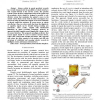Free Online Productivity Tools
i2Speak
i2Symbol
i2OCR
iTex2Img
iWeb2Print
iWeb2Shot
i2Type
iPdf2Split
iPdf2Merge
i2Bopomofo
i2Arabic
i2Style
i2Image
i2PDF
iLatex2Rtf
Sci2ools
ICRA
2005
IEEE
2005
IEEE
Cognitive Based Neural Prosthetics
– Intense activity in neural prosthetic research has recently demonstrated the possibility of robotic interfaces that respond directly to the nervous system. The question remains of how the flow of information between the patient and the prosthetic device should be designed to provide a safe, effective system that maximizes the patient’s access to the outside world. Much recent work by other investigators has focused on using decoded neural signals as low-level commands to directly control the trajectory of screen cursors or robotic end-effectors. Here we review results that show that high-level, or cognitive, signals can be decoded during reaching arm movements. These results, coupled with fundamental limitations in signal recording technology, motivate an approach in which cognitive neural signals play a larger role in the neural interface. This proposed paradigm predicates that neural signals should be used to instruct external devices, rather than control their detailed movemen...
Related Content
| Added | 25 Jun 2010 |
| Updated | 25 Jun 2010 |
| Type | Conference |
| Year | 2005 |
| Where | ICRA |
| Authors | Richard A. Andersen, Sam Musallam, Joel W. Burdick, Jorge G. Cham |
Comments (0)

